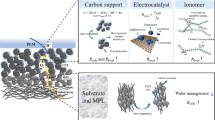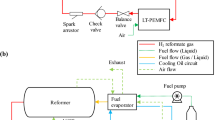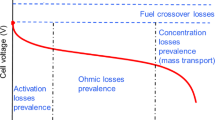Abstract
Progressive thinking about future generation proton exchange membrane fuel cells (PEMFCs) leads us to cost-effective compact fuel cells operating with dry reactants using self-humidifying membranes. Presently, however, PEMFCs are limited by number of factors. One such factor is the reactant impurities present in the feed streams. Chlorine is one such impurity affecting both anode and cathode PEMFC adversely. Several studies have reported adverse impact of anionic chloride in PEMFCs but scarce or no literature is available on the effect of chlorine gas as such on PEMFCs. In the present work, we report for the first time to the best of our knowledge the adverse effects of chlorine when introduced on anode and cathode independently using a single-cell PEMFC. About 94% (anode) and 82% (cathode) loss in performance is observed at an operating voltage of 0.6 V after contamination with 100 ppm chlorine at the anode and cathode respectively. It is found that operating at higher current density plays a significant role in the PEMFC recovery process. The duration of recovery changes for anode-contaminated cell and cathode-contaminated cell, which is 2 and 4 h respectively. The protons on the anode side and the hydroxyl ion at the cathode side help in replacing the chloride species adsorbed on the platinum surface. The electrochemical impedance studies show an increase in the charge transfer resistance after cathode contamination, whereas in the case of anode contamination, the cell resistance increases while maintaining the same charge transfer resistance.

Schematic showing the recovery process of platinum surface by the removal of chloride ion during operation of the cell at 0.1 V







Similar content being viewed by others
References
Zhuang Z, Giles SA, Zheng J, Jenness GR, Caratzoulas S, Vlachos DG, Yan Y (2016) Nickel supported on nitrogen-doped carbon nanotubes as hydrogen oxidation reaction catalyst in alkaline electrolyte. Nat Commun 7:10141
Andreasen KP, Sovacool BK (2015) Hydrogen technological innovation systems in practice: comparing Danish and American approaches to fuel cell development. J Clean Prod 94:359–368
Wang Y, Chen KS, Mishler J, Cho SC, Adroher XC (2011) A review of polymer electrolyte membrane fuel cells: technology, applications, and needs on fundamental research. Appl Energy 88(4):981–1007
Eberle DU, von Helmolt DR (2010) Sustainable transportation based on electric vehicle concepts: a brief overview. Energy Environ Sci 3(6):689
Gencoglu MT, Ural Z (2009) Design of a PEM fuel cell system for residential application. Int J Hydrog Energy 34(12):5242–5248
Debe MK (2012) Electrocatalyst approaches and challenges for automotive fuel cells. Nature 486(7401):43–51
Holton OT, Stevenson JW (2013) The role of platinum in proton exchange membrane fuel cells. Platin Met Rev 57(4):259–271
Duan Q, Wang H, Benziger J (2012) Transport of liquid water through Nafion membranes. J Memb Sci 392–393:88–94
Yang T, Shi P (2006) Performance of PEMFCs with internal humidification. J Electrochem Soc 153:1518–1524
Park CH, Lee SY, Hwang DS, Shin DW, Cho DH, Lee KH, Kim TW, Kim TW, Lee M, Kim DS, Doherty CM, Thornton AW, Hill AJ, Guiver MD, Lee YM (2016) Nanocrack-regulated self-humidifying membranes. Nature 532(7600):480–483
Zhang Y, Zhang H, Bi C a (2008) An inorganic/organic self-humidifying composite membranes for proton exchange membrane fuel cell application. Electrochim Acta 53(12):4096–4103
Cheng X, Shi Z, Glass N, Zhang L, Zhang J, Song D, Liu ZS, Wang H, Shen J (2007) A review of PEM hydrogen fuel cell contamination: impacts, mechanisms, and mitigation. J Power Sources 165(2):739–756
Kakati BK, Kucernak ARJ (2014) Gas phase recovery of hydrogen sulfide contaminated polymer electrolyte membrane fuel cells. J Power Sources 252:317–326
Jayaraj P, Karthika P, Rajalakshmi N, Dhathathreyan KS (2014) Mitigation studies of sulfur contaminated electrodes for PEMFC. Int J Hydrog Energy 39(23):12045–12051
Kumar Kakati B, Unnikrishnan A, Rajalakshmi N et al (2016) Recovery of polymer electrolyte fuel cell exposed to sulphur dioxide. Int J Hydrog Energy 41(12):5598–5604
Zhai Y, Bender G, Bethune K, Rocheleau R (2014) Influence of cell temperature on sulfur dioxide contamination in proton exchange membrane fuel cells. J Power Sources 247:40–48
Verhage AJL, Coolegem JF, Mulder MJJ, Yildirim MH, de Bruijn FA (2013) 30, 000 h operation of a 70 kW stationary PEM fuel cell system using hydrogen from a chlorine factory. Int J Hydrog Energy 38(11):4714–4724
Li H, Wang H, Qian W, Zhang S, Wessel S, Cheng TTH, Shen J, Wu S (2011) Chloride contamination effects on proton exchange membrane fuel cell performance and durability. J Power Sources 196(15):6249–6255
Uddin M, Wang X, Qi J et al (2015) Effect of chloride on PEFCs in presence of various cations. JElectrochemSoc 162(4):F373–F379
Ali ST, Li Q, Pan C, Jensen JO, Nielsen LP, Møller P (2011) Effect of chloride impurities on the performance and durability of polybenzimidazole-based high temperature proton exchange membrane fuel cells. Int J Hydrog Energy 36(2):1628–1636
Arruda T, Shyam B (2008) Investigation into the competitive and site-specific nature of anion adsorption on Pt using in situ X-ray absorption spectroscopy. J Phys Chem C 112(46):18087–18097
Strmcnik D, Gaberscek M, Hocevar S, Jamnik J (2005) The effect of halide ion impurities and Nafion on electrooxidation of CO on platinum. Solid State Ionics 176(19-22):1759–1763
Yadav AP, Nishikata A, Tsuru T (2007) Effect of halogen ions on platinum dissolution under potential cycling in 0.5 M H2SO4 solution. ElectrochimActa 52(26):7444–7452
Li H, Zhang S, Qian W, Yu Y, Yuan XZ, Wang H, Jiang M, Wessel S, Cheng TTH (2012) Impacts of operating conditions on the effects of chloride contamination on PEM fuel cell performance and durability. J Power Sources 218:375–382
Schmidt TJ, Paulus U, Gasteiger H, Behm RJ (2001) The oxygen reduction reaction on a Pt/carbon fuel cell catalyst in the presence of chloride anions. J Electroanal Chem 508(1-2):41–47
Gutleben H (1990) Adsorption of chlorine on the Pt (100) face: structural aspects and desorption kinetics. Surf Sci 236(3):313–324
Devivaraprasad R, Kar T, Leuaa P, Neergat M (2017) Recovery of active surface sites of shape-controlled platinum nanoparticles contaminated with halide ions and its effect on surface-structure. J Electrochem Soc 164(9):H551–H560
Acknowledgements
The authors would like to acknowledge the Director, ARCI for his constant support and encouragement. Financial assistance from DST-RCUK (SR/RC-UK/FUEL CELL01/2011/CFCT (G)) is acknowledged herewith.
Author information
Authors and Affiliations
Corresponding author
Rights and permissions
About this article
Cite this article
Unnikrishnan, A., Janardhanan, V.M., Rajalakshmi, N. et al. Chlorine-contaminated anode and cathode PEMFC-recovery perspective. J Solid State Electrochem 22, 2107–2113 (2018). https://doi.org/10.1007/s10008-018-3921-3
Received:
Revised:
Accepted:
Published:
Issue Date:
DOI: https://doi.org/10.1007/s10008-018-3921-3




